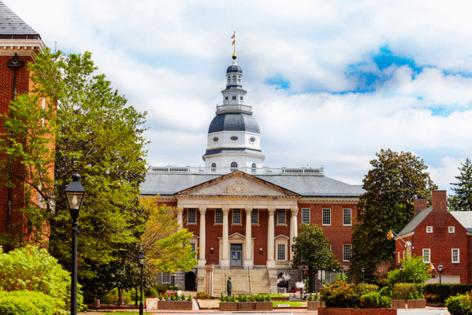Likely Maryland voters prefer 'strict' juvenile justice laws in recent poll, though some object to question's framing
Published in News & Features
BALTIMORE — A recent statewide poll found that a majority of likely Marylander voters, about 58%, prefer “strict” juvenile justice laws over “lenient” ones, which secured roughly 34% support.
That majority preference persisted among Democrats, Republicans, white respondents, Black respondents and each age group — and remain largely unchanged from last year.
The poll results, released this week, come as juvenile justice reform remains a hot topic in Maryland, and on the heels of some changes approved in the spring legislative session. The poll question did not delve into specifics about state laws or policies, however, and some questioned whether its framing sufficiently captured the nature of ongoing debates.
“The question posits a choice between harshness and leniency that makes reformers and researchers look like clowns. Everyone believes in accountability. The question is how best to achieve it,” said Josh Rovner, the director of youth justice at The Sentencing Project, an advocacy group seeking a more equitable criminal justice system.
Rovner said it would be a legitimate public policy question to ask voters or residents whether they think the justice system is too lenient or too harsh and whether it is effective or ineffective. But the most “essential” question, he said, would be whether policies and programs in place actually work.
“If we care about public safety, we should care about what works, not about what one’s gut instinct says should work,” Rovner said.
Others cheered the poll’s finding, saying it confirmed what residents have said since the pandemic. Baltimore State’s Attorney Ivan Bates, who helped lead the charge for reforms in the spring, said the results “echo what I hear in every corner of our city.”
“Now more than ever, residents have been touched by crime. It may not be a violent crime, but they’ve been robbed or had their car stolen, or their neighbor or someone else they know has,” Bates said in an email. “In many of these instances, the culprits were either juveniles or identified as juveniles, leaving the victims with little to no information and even less recourse.”
Bates said he was dedicated to striking “the right balance” between ensuring accountability for young people, ensuring they receive resources to “become productive members of our city” and ensuring justice for any victims.
Patrick E. Gonzales, with Gonzales Research & Media Services, did not respond to a request Thursday for comment about the criticisms of the question. He also did not say whether he had been paid by any entity to pose the question. Gonzales Research has a long history of regular polling in Maryland, and estimates having polled and analyzed thousands of elections here and across the country over the past 40 years.
The juvenile justice system in the country is similar in some ways to the adult criminal system but operates under the guiding principle that youth are different from adults. The juvenile system seeks to rehabilitate young people, offering “treatment” as a standard part of the conclusion of charges and seeking to help them avoid future delinquency.
The Maryland General Assembly, earlier this year, passed a sweeping bill aimed at the juvenile system. Among other things, the bill requires clearer communication with police and prosecutors by the state’s Department of Juvenile Services, creates new services for young children accused of car theft and codifies a state program called Thrive that seeks to help youth most likely of becoming victims or perpetrators of gun violence.
The legislation, signed into law by Gov. Wes Moore despite a call for him to veto it, also expands the charges a child who is between 10 and 12 years old can face. Those charges now include some firearms offenses, aggravated animal cruelty and third-degree sex offenses, in addition to the preexisting crimes of violence.
The poll question asked by Gonzales Research did not delve into those recent reforms or specific aspects of existing juvenile justice law. It asked respondents whether they preferred “strict” laws, like detention and boot camps that hold “individuals responsible and accountable for their behavior” or “lenient” ones, including social programs and counseling, that recognize “society is responsible for much of this behavior.”
Maryland’s boot camps for juveniles were closed in 1999 because guards were beating teens, some while they were handcuffed and shackled; the state in 2001 paid out more than $4 million to 900 of those young people. The National Institute of Justice, a part of the U.S. Department of Justice, rates juvenile boot camps as having “no effects” on the likelihood of participants’ recidivism.
Meanwhile, Maryland’s system regularly detains young people — and commits them, the term for when someone is held after the conclusion of their delinquency matter.
In fiscal year 2023, the most recent for which data is available, the average daily population in youth detention in Maryland was 212 young people, a figure that includes youth charged as adults.
Of the 588 young people who were detained before the disposition of their cases in fiscal year 2023, nearly 47% were assessed as “low-risk.” The state agency reported 90.2% of those detained before their case dispositions were youth of color.
In the same time period, the average daily population in committed residential facilities was 139 people.
Maryland’s system also regularly employs counseling, like systems across the country. Cognitive behavioral therapy has been found to effectively reduce aggression in young people, and multisystemic therapy reduces recidivism, according to the National Institute of Justice.
The Department of Juvenile Services declined to comment on the poll. The agency, under Secretary Vincent Schiraldi, defines its mission as transforming young people’s lives, creating safer communities and forming more equitable systems. It strives to, with community-based partners, “hold youth accountable while building on their strengths and support systems.”
Rovner said the definition of a harsh system should be about how often youth are detained or committed and how often they are charged as if they are adults, not whether they are detained or committed at all.
Under that framework, Maryland would be viewed as harsh in sending young people to the adult system based on the alleged offense. There are 33 charges that, under state law, automatically send kids to the adult system, Rovner said, and “in no way is that typical.”
A separate nationwide poll released in December found Americans were evenly split on whether teens who commit violence should be treated the same as adults or given more “lenient” treatment in juvenile courts. That Gallup poll’s 46-47 split, respectively, marked a shift from two decades ago when 65% thought teen offenders should be treated like they were adults.
The Maryland poll by Gonzales was delivered to 820 likely Maryland voters from Aug. 24 through Aug. 30. It found a jump in approval ratings for Moore and Vice President Kamala Harris and a lead for Democrat Angela Alsobrooks over Republican Larry Hogan in their race for the U.S. Senate.
In the poll’s appendix, responses to the juvenile justice question were further broken out by demographics. Republicans favored “strict” laws at an 82.2% rate, while Democrats did at a 51.7% rate. Of those, Black Democrats favored “strict” laws at a 63% rate, while white Democrats did at a 35.3% rate.
The poll also highlighted differences within the population of Black respondents. Of the 247-person pool, 79.1% of Black men favored “strict” laws, while 53.2% of Black women did. In the same pool, 19.8% of Black men favored “lenient” laws, compared to 46.8% of Black women. (The same breakdown by race and gender was not provided for white respondents.)
Geographically, the Washington D.C. suburbs were the least supportive of “strict” laws and the most supportive of “lenient” laws. In Baltimore City, 67.2% of respondents favored “strict” and 28.4% favored “lenient.”
Heather Warnken, executive director of the Center for Criminal Justice Reform at the University of Baltimore School of Law, said it’s important to phrase poll questions in a way that results in data that informs conversations in a meaningful way.
Here, she said, the wording “absolutely” could have been leading, by pitting “strict” laws against “lenient” ones — and she cautioned there could be harm in conflating “strict” laws with effective ones, without first reviewing years’ worth of research about effective strategies.
“I think it’s really important that we’re hearing loud and clear from polls like this that people want public safety to be taken seriously, and they want solutions that are effective,” Warnken said. “That’s not the same thing as making them strict or punitive.”
Bates, in his email response to questions, said young people pose a “unique challenge” within the justice system. Accountability for young people, he said, doesn’t only mean incarceration.
“It also involves offering these young offenders a path to rehabilitation through DJS programming,” Bates said. “Ultimately, my focus is and will always be on the trauma inflicted upon our communities and the victims of crime in Baltimore, ensuring they receive the justice, care, and respect they deserve.”
Maryland’s juvenile justice laws are a “work in progress,” Bates said. He argued recent changes need to be “adeqeuately assessed” over time, before any “necessary adjustments.”
---------
©2024 The Baltimore Sun. Visit at baltimoresun.com. Distributed by Tribune Content Agency, LLC.







Comments